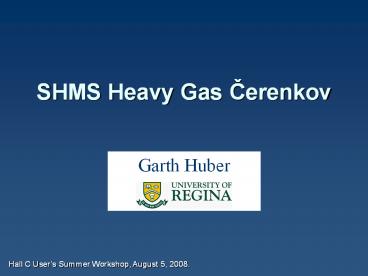SHMS Heavy Gas Cerenkov - PowerPoint PPT Presentation
Title:
SHMS Heavy Gas Cerenkov
Description:
At higher momenta, hadron species cannot be reliably distinguished by time of ... Stable, non-toxic, non-explosive, non-reactive (except with alkali halide metals) ... – PowerPoint PPT presentation
Number of Views:39
Avg rating:3.0/5.0
Title: SHMS Heavy Gas Cerenkov
1
SHMS Heavy Gas Cerenkov
Hall C Users Summer Workshop, August 5, 2008.
2
Introduction
- At higher momenta, hadron species cannot be
reliably distinguished by time of flight over the
2.2 m SHMS detector stack baseline. - Good PID can be obtained with a series of
Cerenkov detectors - e-/p- ? Noble Gas Cerenkov (n-1 lt 10-4)
- p/K ? Heavy Gas Cerenkov (n-1 10-3)
- K/p ? Aerogel Cerenkov (n-1 0.03)
- Heavy Gas Cerenkov will be the primary means for
p/K separation above 3.4 GeV/c. - 1 m long cylinder with 1.6 m diameter, to be
operated at sub-atmospheric pressure.
3
- Gap between the set and K curves takes into
account the SHMS momentum bite and a possible 0.1
atm error in the setting of the gas pressure
regulator.
- Gas recirculation and purification system needed
since gas pressure will be changed at higher
SHMS momenta. - Maintain sub-atmosphere (0.95 atm) pressure below
7.3 GeV/c. - Above 7.3 GeV/c, reduce gas pressure to maintain
good p/K separation.
4
Focal Plane Coverage
- Non-magnetic stainless steel pressure vessel.
- 1.6m diameter cylinder.
- Titanium entrance and exit windows.
5
Optical Ray Tracing Studies
- Co-ordinating design with Donal Day.
- Four thin glass spherical mirrors (50cmx55cm,
radius175cm) each viewed by a 5 PMT. - Asymmetric SHMS envelope dictates different
mirror and PMT placements for d.
6
Projected Performance
Projected p.e. assuming 0.6m effective radiator
path length and possible optical misalignment.
Useful (7 p.e.) lower momentum limit estimated to
be 3.4 GeV/c.
7
Updated Timeline
- Design 2008-2010.
- GuideIt studies (CERN optics package).
- Mechanical design.
- NSERC grant application Fall 2009.
- New date dictated by DOE timeline and recent
comments by NSERC re. possible GlueX BCAL
support. - Construction 2011-2012.
- Delivery to JLab Winter, 2013.
- Installation in Hall C Summer, 2013.
- Detector checkout (no beam) Winter, 2014.
8
(No Transcript)
9
Radiator Gas Update
- The heavy gas originally intended for this
detector was C4F10. - 3M stopped production of this gas some years ago,
although it might still be available from a U.K.
supplier (gt300/kg). - C4F8O appears to be the optimal substitute.
- Widely used in the semiconductor industry for
plasma etching. - Easily available from many commercial suppliers.
- Extensively studied by the BTeV collaboration for
use in their RICH detector, including beam tests
of their prototype. - T. Skwarnicki, NIM A 553 (2005) 339-344.
- N. Artuso, et al., NIM A 558 (2006) 373-387.
10
(No Transcript)
11
Properties ofC4F8O (OctaFluoroTetraHydroFuran)
- Gas phase is about 10 times heavier than air
(9.19 g/L at 21oC). - Boiling point -5oC.
- Vapor pressure 1.7 atm _at_ 21oC.
- Stable, non-toxic, non-explosive, non-reactive
(except with alkali halide metals). - BTeV performed 10 year equivalent exposure tests
with a variety of materials (plastics, mirror
material, epoxies, composites, water). - No measurable changes seen.
- Can pick-up and transport oils.
- need to avoid contact with organic materials.
- Unlike C4F10, it does not destroy ozone.
- Rated as having high global warming potential due
to its long atmospheric lifetime if released. - About 100/kg.
12
(No Transcript)
13
Schematic Design
- Non-magnetic stainless steel pressure vessel.
- 1.6m diameter cylinder.
- Titanium entrance and exit windows.
- Four high quality thin glass spherical mirrors
(50cmx55cm) - Structurally reinforced outside beam envelope.
- A gas recirculation and purification system is
needed since the gas pressure will be changed
frequently for pSHMSgt7.4 GeV/c.
14
Primary Design Components
- Protected mirror coatings.
- Reference Al coating from Lambda/Ten Optics.
- gt90 reflectivity down to 200 nm.
- PMTs view enclosure through 1cm UV-grade window.
- Allows for better isolation of the pressurized
cavity. - Photonis flat-face 5 PMTs mounted flush to
window. - Bases to incorporate voltage boost between
photocathode and first dynode to provide optimum
focusing of photoelectrons.
15
Integration
- Will deliver
- Pressure tested Cerenkov enclosure.
- Mounted and aligned mirrors.
- PMTs with custom bases.
- Will need to co-ordinate with JLab staff
- Location of mounting and alignment fixtures.
- Design, location and fabrication of gas recovery
and purification system. - Expecting JLab to provide
- Readout electronics, HV channels, cables.
- Mounting and alignment on SHMS detector frame.
- User interface for remote pressure change when
- pSHMS changes.
- Coordination with U.Virginia (Noble Gas
Cerenkov) - Design, and procurement, where appropriate.
16
Funding
- Cost estimate
- 142k (FY07), Contingency 33k (23).
- I intend to submit a Research Tools and
Instrumentation (RTI) request to NSERC in Fall,
2008. - Timing of request is dictated by necessity of
CD-3 granting prior to Canadian funding
deliberations in early 2009. - NSERC grants are announced April 1 each year.
- If the NSERC grant request is successful, it will
count as a foreign contribution to the Hall C
upgrade and help relieve pressure on the 12 GeV
cost book.































